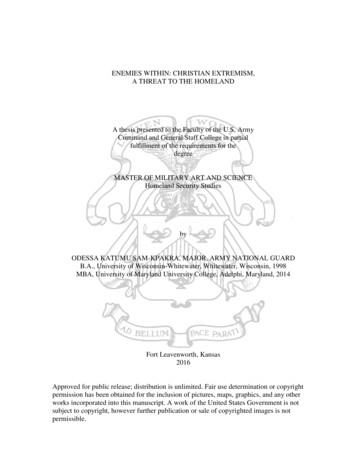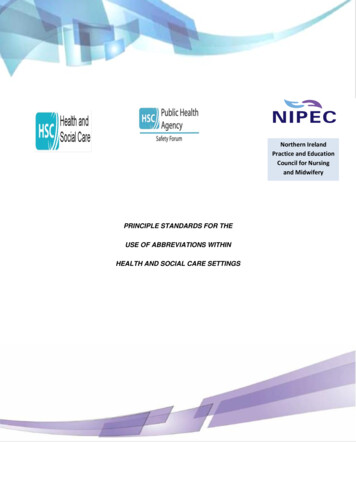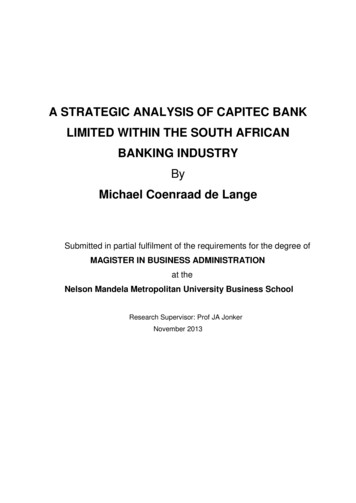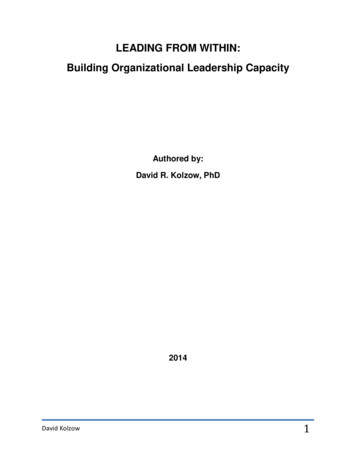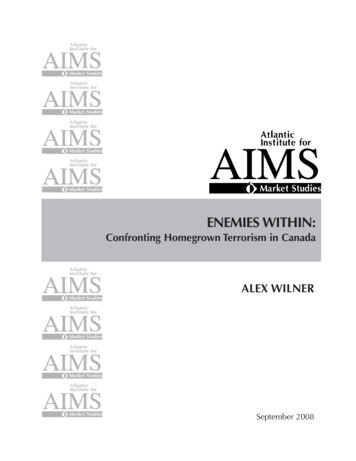
Transcription
ENEMIES WITHIN:Confronting Homegrown Terrorism in CanadaALEX WILNERSeptember 2008
Atlantic Institute for Market StudiesThe Atlantic Institute for Market Studies (AIMS) is an independent, non-partisan, social and economicpolicy think tank based in Halifax. The Institute was founded by a group of Atlantic Canadians to broadenthe debate about the realistic options available to build our economy.AIMS was incorporated as a non-profit corporation under Part II of the Canada Corporations Act and wasgranted charitable registration by Revenue Canada as of October 3, 1994; it recently received US charitablerecognition under 501(c)(3) effective the same date.The Institute’s chief objectives include:a) initiating and conducting research identifying current and emerging economic and public policy issuesfacing Atlantic Canadians and Canadians more generally, including research into the economic and socialcharacteristics and potentials of Atlantic Canada and its four constituent provinces;b) investigating and analyzing the full range of options for public and private sector responses to the issuesidentified and acting as a catalyst for informed debate on those options, with a particular focus on strategiesfor overcoming Atlantic Canada’s economic challenges in terms of regional disparities;c) communicating the conclusions of its research to a regional and national audience in a clear, non-partisanway; andd) sponsoring or organizing conferences, meetings, seminars, lectures. training programs, and publications,using all media of communication (including, without restriction, the electronic media) for the purpose ofachieving these objectives.Board of DirectorsChair: John F. Irving; Vice-Chairs: Peter C. Godsoe, Dianne KeldermanChairman Emeritus: Purdy CrawfordDirectors: George E. Bishop, George T.H. Cooper, Brian Lee Crowley, Jim Dinning, J. Colin Dodds,Douglas G. Hall, Frederick E. Hyndman, Phillip R. Knoll, Earl Ludlow, Martin MacKinnon, Louis J.Maroun, G. Peter Marshall, John T. McLennan, Norman Miller, Don Mills, Perry Newman, Andrew Oland,Derrick H. Rowe, Jacquelyn Thayer Scott, Vaughn Sturgeon, Heather Tulk, Peter G. ViguePresident: Brian Lee CrowleyAdvisory CouncilAngus A. Bruneau, R.B. Cameron, Purdy Crawford, Ivan E.H. Duvar, James Gogan, Bernard Imbeault,Colin Latham, Denis Losier, Hon. Peter Lougheed, David McD. Mann, James W. Moir Jr., James S. Palmer,Gerald L. Pond, John Risley, Cedric E. Ritchie, Joseph Shannon, Allan C. Shaw, Paul SobeyBoard of Research AdvisorsChair: Professor Robin F. Neill, University of Prince Edward IslandIsabel B. Anderson; Professor Charles S. Colgan, Edmund S. Muskie School of Public Service, Universityof Southern Maine; Professor Doug May, Memorial University of Newfoundland; Professor James D. McNiven,Dalhousie University; Professor Robert A. Mundell, Nobel Laureate in Economics, 19992000 Barrington Street, Suite 1302, Halifax, Nova Scotia B3J 3K1Telephone: (902) 429-1143; fax: (902) 425-1393E-mail: aims@aims.ca; Web site: www.aims.ca
ENEMIES WITHIN:Confronting HomegrownTerrorism in CanadaALEX WILNERAtlantic Institute for Market StudiesHalifax, Nova ScotiaSeptember 2008
ii 2008 Atlantic Institute for Market StudiesPublished by Atlantic Institute for Market Studies2000 Barrington Street, Suite 1302Halifax, Nova Scotia B3J 3K1Telephone: (902) 429-1143Fax: (902) 425-1393E-mail: aims@aims.caWeb site: www.aims.caEdited and prepared for publication by Barry A. Norris; design by Gwen North.The author of this report has worked independently and is solely responsible for the viewspresented here. The opinions are not necessarily those of the Atlantic Institute for Market Studies, itsDirectors, or Supporters.Enemies Within
iiiCONTENTSAbout the Author . . . . . . . . . . . . . . . . . . . . . . . . . . . . . . . . . . . . . . . . . . . . . . . . . . . . . . . . . . . . . .ivExecutive Summary . . . . . . . . . . . . . . . . . . . . . . . . . . . . . . . . . . . . . . . . . . . . . . . . . . . . . . . . . . . . .vIntroduction . . . . . . . . . . . . . . . . . . . . . . . . . . . . . . . . . . . . . . . . . . . . . . . . . . . . . . . . . . . . . . . . . . . .1The Making of Homegrown Terror . . . . . . . . . . . . . . . . . . . . . . . . . . . . . . . . . . . . . . . . . . . . . . . . .3Tackling Terrorism at Home . . . . . . . . . . . . . . . . . . . . . . . . . . . . . . . . . . . . . . . . . . . . . . . . . . . . . . .8Counterterrorism in the Coming Decade . . . . . . . . . . . . . . . . . . . . . . . . . . . . . . . . . . . . . . . . . . . .27References . . . . . . . . . . . . . . . . . . . . . . . . . . . . . . . . . . . . . . . . . . . . . . . . . . . . . . . . . . . . . . . . . . . .28Enemies Within
ivABOUT THE AUTHORAlex S. Wilner is a post-doctoral fellow with the Transatlantic Post-Doc Fellowship for InternationalRelations and Security (TAPIR). As part of the fellowship, Alex will be stationed as a visiting scholarwith the Center for Security Studies (Zurich), the German Institute for International and Security Affairs(Berlin), and the RAND Corporation (Washington, DC). Alex is in the final stages of completing hisDoctorate in political science at Dalhousie University and has a Master’s degree from DalhousieUniversity and a Bachelor’s degree from McGill University. His dissertation research has beenawarded both a Social Science and Humanities Research Council of Canada Scholarship and aDr. Ronald Baker Doctoral Scholarship. Alex’s academic interests involve the study of conflict andinternational relations, with a primary focus on applying deterrence theory to counterterrorism.Enemies Within
vEXECUTIVE SUMMARYThe nature of global terrorism has evolved. The arrest of a number of Canadians in Toronto in2006 for allegedly planning to kill fellow citizens is but one case of a growing trend of homegrown terrorism. (As this paper goes to publication, the “Toronto 18” case continues to unfold. OnSeptember 25, 2008, an unnamed member of the group who was still a youth at the time of thearrests was found guilty under Canada’s anti-terrorism law.)Consider that none of the young men rounded up in Ontario was a foreign national, had been specifically recruited by al-Qaeda, had acquired any training in a terrorist camp in Afghanistan, Pakistan,or elsewhere, or had been dispatched to attack Canada by Osama bin Laden, Ayman al-Zawahiri(al-Qaeda’s deputy), or any other al-Qaeda leader. For all intents and purposes, the group wasautonomous, self-generated, and independently trained. Worse, its members were Canadian, throughand through.While the threat of homegrown terrorism in Western states is not new, the rise of al-Qaeda- and jihadiinspired Muslim homegrown terrorism is. With a little encouragement, individuals predisposed tosupport al-Qaeda’s radical Islamic ideology form small yet intricate cells and networks. From there,it is a short step to the sort of “al-Qaeda-inspired terrorism” the Toronto Group allegedly sought.Moreover, Canadians are not alone. Since 2001, our friends and allies in Denmark, Germany, theUnited States, the United Kingdom, Australia, and elsewhere in Europe and Asia have been challenged by the same phenomenon.Understanding how to combat homegrown terrorism will require an innovative, multifaceted, andcoordinated strategy. This paper offers four such strategies.First, the Canadian government should gain a better understanding of the particular pathways thatlead ordinary Canadians to embrace and employ violence against fellow nationals. By appreciatingwhat drives the radicalization process, Canadians will be in a better position to influence and impedeits development.Second, Canada should more readily monitor local elements that preach, incubate, and fosterideologies of hatred and violence. While self-radicalization is possible, an embrace of terrorism andviolence is more often than not fortified by ideological or practical guidance from above. Communityleaders who advocate and promote violence against Canadians should be deterred from doing so.Third, Ottawa should consider using the Internet not only to uncover, track, and impede terroristinfrastructure and planning in Canada, but also to disseminate the rationales that underpin Canada’sEnemies Within
videfence and foreign policy. The Internet is not only a useful counterterrorism tool, but also anapparatus for contradicting extremist viewpoints while arming moderate ideological factions.Finally, if and when a homegrown terrorist group or plot is uncovered, the Canadian governmentshould use all of its facilities to disrupt and foil the threat. To do so effectively and expeditiously,Canada should retain a robust intelligence-gathering and policing capability and uphold the interagency and international cooperative relationships it will need to manage terrorist threats wheneverand wherever they may arise.Enemies Within
1INTRODUCTIONOn the morning of June 3, 2006, Canadians woke to the news that the country’s security services hadsucceeded in thwarting a major terrorist threat. In a series of raids that involved more than 400 policeand security personnel working together across a number of locations in southern Ontario, 17 suspectswere apprehended.1 An eighteenth arrest was made two months following the initial operation.The so-called Toronto Group, it is alleged, had intended to attack the Parliament Buildings, storm CBCoffices in Toronto, take hostages, and even behead the prime minister.2 In preparation, the suspectsallegedly had ordered, received, and stored three metric tonnes of ammonium nitrate — an easily3accessible fertilizer that doubles as a bomb ingredient when mixed with the right components. Bycomparison, Timothy McVeigh — the Oklahoma City Bomber — used merely one-third that amountof ammonium nitrate in his 1995 truck bombing of the Alfred P. Murrah Federal Building that killed168 people. It is not difficult to imagine the amount of destruction the Toronto Group might haveinflicted had it been able to carry out its plans.The Toronto Group supposedly had been preparing its attacks for months. It was fond of travellingto the wilds of Ramara Township, roughly 150 kilometres north of Toronto, for week-long trainingexcursions in makeshift survival camps (Wattie 2006). “This group posed a real and serious threat,”RCMP Assistant Commissioner Mike McDonell stated the day of the raids. “It had the capacity andintent to carry out attacks. Our investigation and arrests prevented the assembly of any bombs andthe attack [from] being carried out.”4Of the 18 suspects, three — all youths under age 18 when apprehended — had their charges stayedin 2007. Another four were released in April 2008, although three of them were required to sign“peace bonds” allowing the court to impose “strict conditions” on an individual “if it deems thereare reasonable grounds to believe a terror-related offence will be committed.” In March 2008, the trialof the remaining suspects — accused of participating in and aiding the activity of a terrorist group— began in Brampton, Ontario, marking the first time individuals had been charged under Canada’santi-terrorism legislation, introduced in 2001 following the 9/11 attacks (Teotonio 2008a, 2008b).1 See “Two youths freed in bomb plot case,” CBC News, July 31, 2007; Leong (2008); Teotonio (2008c).2 “Suspects accused of wanting to behead PM, lawyer claims,” CBC News, June 6, 2006; “CBC building in Torontomay have been target,” CBC News, June 6, 2006.3 According to reports published by the Toronto Star and the CBC, RCMP officers intercepted a shipment of ammonium nitrate destined to the group and substituted it with a “harmless powder” before the delivery was made. See“Indepth: Toronto bomb plot: Ammonium nitrate,” CBC News, June 5, 2006; and Teotonio (2008).4 “Indepth: Toronto bomb plot,” CBC News, January 9, 2008, updated.Enemies Within
2On the surface, the Toronto bust seems like another of the many successful counterterrorismoperations conducted worldwide. Indeed, since al-Qaeda’s devastating attack on New York andWashington, DC, dozens of plots have been uncovered, disrupted, and foiled from Germany to Yemen.But the Toronto case differs from many of these plots in being an example of the emergingphenomenon of homegrown terrorism. Consider that none of the young men rounded up in Ontariowas a foreign national. All the adult suspects — the remaining teenagers cannot be identified underthe Youth Criminal Justice Act — were Canadian citizens or landed immigrants. Most were born,raised, and educated in Canada, while those who had been born abroad had moved to Canada asyoungsters.5 None had been specifically recruited or supported by al-Qaeda or one of its affiliategroups. None had had any contact with or acquired any training in a terrorist camp in Afghanistan,Pakistan, or elsewhere. Neither had any of them been specifically dispatched to attack Canada byOsama bin Laden, or al-Qaeda’s deputy, Ayman al-Zawahiri, or any other al-Qaeda leader. For allintents and purposes, the Toronto Group was autonomous, self-generated, and independently trained.“What we’re onto scares us,” explained McDonell following an address to an Ottawa conference oncritical infrastructure protection in May 2008. He noted, rather candidly, that the RCMP was activelyinvestigating seven suspected terrorist plots in Canada and more than 800 other national securitycases. Even then, he added, “what we’re not onto really scares us” (MacLeod 2008b).Canadians are today on trial for allegedly planning to kill and maim their fellow citizens. In light ofthis development, what is Canada to do?5 “Indepth: Toronto bomb plot: Profiles of the suspects,” CBC News, November 5, 2007.Enemies Within
3THE MAKING OFHOMEGROWN TERROR“For various reasons, [the Toronto Group] appear to have become adherents of a violentideology inspired by al-Qaeda. Any movement that has the ability to turn people against theirfellow citizens is obviously some
ENEMIES WITHIN: Confronting Homegrown Terrorism in Canada September 2008. Atlantic Institute for Market Studies The Atlantic Institute for Market Studies (AIMS) is an independent, non-partisan, social and economic policy think tank based in Halifax. The Institute was founded by a group of Atlantic Canadians to broaden the debate about the realistic options available to build our economy. AIMS .
